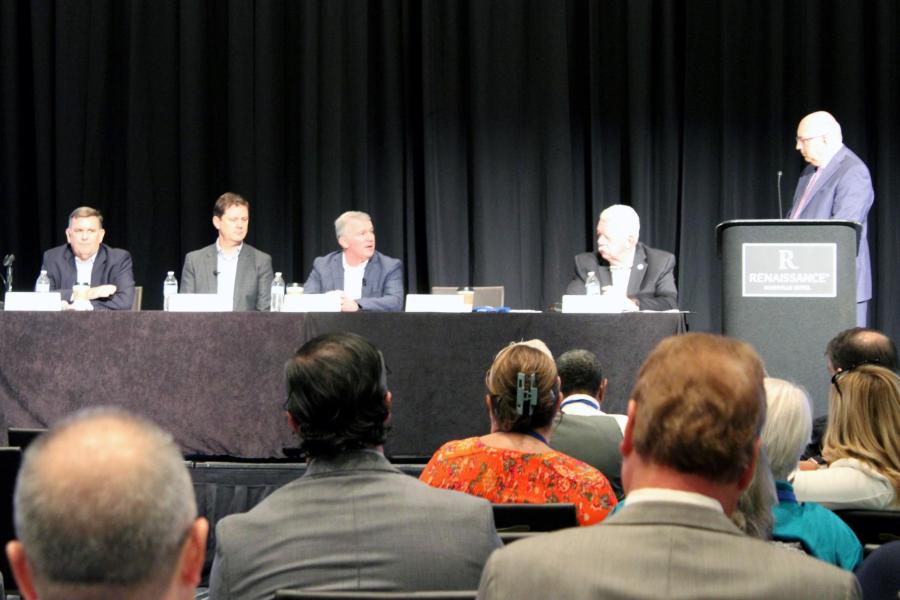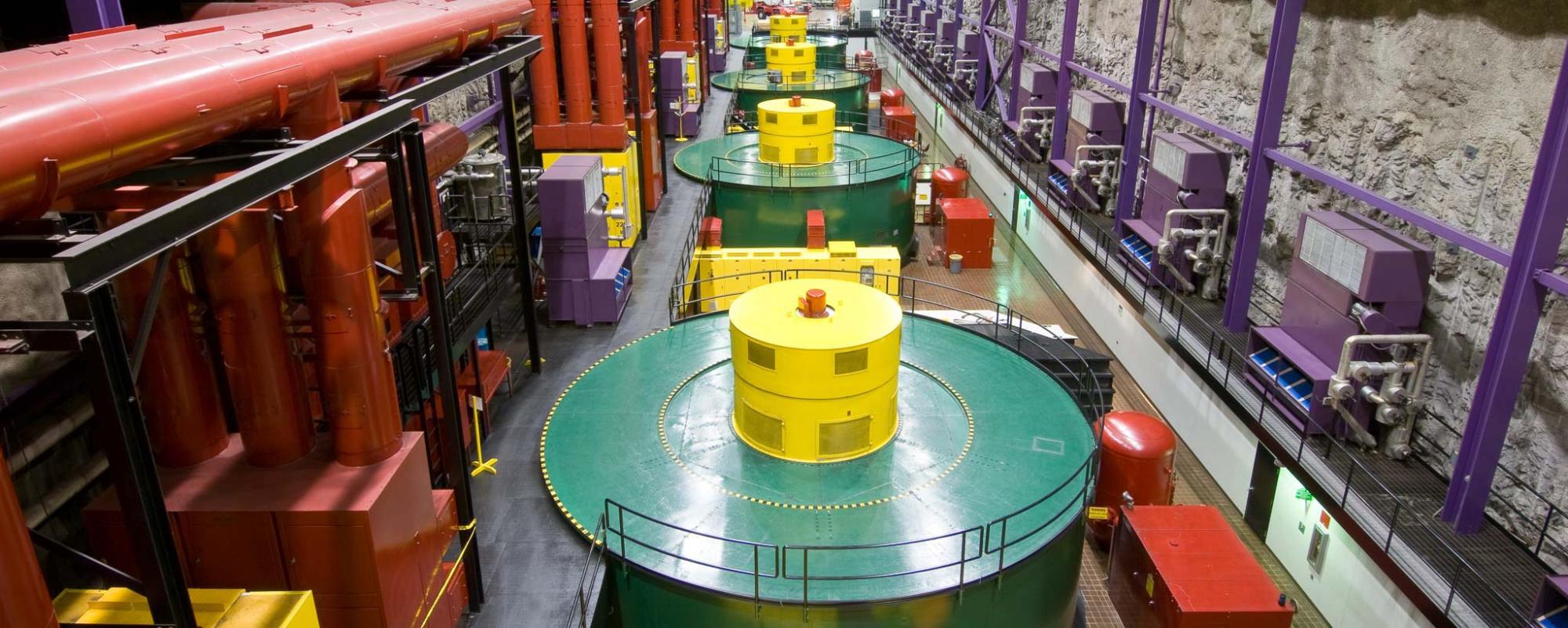Electric industry leaders discuss EVs, future of utility at TML Conference

By KATE COIL
TML Communications Specialist
As electric vehicles become more prominent, technology changes, and consumer demand increases, the ways in which electric power and energy are both generated and utilized are changing rapidly.

Industry leaders Tennessee Municipal Power Association (TMPA) CEO Brian Solsbee, Tennessee Electric Cooperative CEO Mike Knotts, and TVA Regional Vice President Justin Mairehofer discussed the challenges being faced and how municipalities can be part of the solution at the TML 83rd Annual Conference in Nashville.
Mairehofer said TVA is charged by the federal government with meeting certain standards.
“As far as reliability and generation, it helps when your mission is written in Congressional statute,” Mairehofer said. “It makes it easy because you know what it is you’re supposed to be doing. That mission is what we call the three E’s. Those are providing affordable, reliable electricity; supporting environmental stewardship; and promoting economic development. The way I like to think about it is we keep the lights glowing, the river flowing, and the valley growing.”
Since the pandemic, TVA has been feeling the region’s population growth.
“That growth in the southeast is tremendous,” Mairehofer said. “A lot of people across the country are moving to the southeast. With industry and residential customers – we’re seeing an explosion of growth, and with that growth comes an enormous amount of demand on our system. We had a decade of flat load growth, but in 2020 things started to change a little bit. We have increased our load by 1,000 megawatts since 2020. That’s about 500,000 homes that we deliver electricity to. We are expecting that load growth to continue for the next three to five years. So, we have to build generation.”
As TVA moves forward, Mairehofer said the agency is looking into sources of power.
“If we could figure a way to make electrons out of humidity, we’d probably do it,” he said with a laugh. “We like nuclear. We like gas. We still have coal running. We love hydro. Hydro power is the cheapest fuel because rain is free. Getting 10-15% from hydropower every year is powerful, and it’s a cheap source of generation for TVA.”
Knotts said electric cooperatives are also seeing changes brought by expanding populations. At present, he said all of TVA’s power plants operating at full capacity at once would generate about 32,000 megawatts of power.

“This is a different world in the electric power industry,” Knotts said. “You’ve not really had to think that much about what we do on a daily basis, and we take a lot of pride in that. When you flip the switch, the lights come on, and you don’t think for a second that there was an army of people and machinery and – what many people have said is the greatest invention of all time – central station electric service. That may be changing over time.”
Solsbee said investments are already being made to counteract the rapid growth the region is experiencing.
“No one in here was happy when we had to talk about blackouts,” he said. “We are working to make sure we understand what it takes to keep the lights on. We have 3,000 megawatts under construction that will be coming on line so we don’t fall short of the growth. It’s very hard and challenging as we’ve had a flat load growth and you don’t want to overbuild. There is a lot of cost and expenses there. Now the growth is starting to take off again.”
With multiple major automakers switching primarily to EV models within the next decade, the electric industry is also considering this impact to the grid. Knotts said that even those who are adamant about keeping their gas vehicles have to recognize how the EV revolution is going to change things.
“The electric vehicle transition is real, and it’s not something to fear,” Knotts said. “This is coming from a guy who is a car enthusiast... I’m an eternal combustion enthusiast, and I’m an electric vehicle enthusiast. I think for the considerable future we’re going to have a world of both. Here’s some statistics for you: Last year 6% of new vehicles sold in America were electric vehicles. For a guy who likes EVs, likes how they drive, and sells electricity, that’s a good thing. The flip side of that is 94% of the vehicles sold in this country were internal combustion engine vehicles that will be on the road for the next 20 to 30 years. This transition might be slower than those trying to stoke the fears of partisan politics may tell you, but it’s also very real. Next year, that 6% may go to 8% then 10% the year after.”
Knotts said the two main questions he gets about EVs are where vehicles will be charged and how much it will cost to charge them. He said there are already 62 million charging locations across the U.S. alone – the average family home. While there will be charging opportunities while traveling, Knotts said the majority of EV drivers will do their charging at home.
“For the time being, we hope you do that charging at night because literally at night there is more capacity on the electric grid,” he said. “The potential for EV growth is fueling this local growth and demand we are looking at. A lot of it has to do with timing. Electricity is the one thing you purchase where when you consume that product makes a big difference in the cost of producing that project. Until we can change things technologically, we have to produce the electricity that turns the lights on at a power plant right then and transmitting it there instantaneously.”

Because the power is instant, Knotts said there could be challenges in capacity. Having vehicles charging at night when most people are not using other sources of power like their lights or appliances will help reduce strain on the grid. He said the two things that will change are habits in how we drive our vehicles and the cost. Instead, charging overnight will allow people to have a full fuel tank every morning when they wake up. Fueling vehicles at home will also cost a third of what gasoline does.
Solsbee said some areas of the country will adopt electric vehicles faster than others. With major economic investments coming from Tennessee automakers, he said EVs may have other economic impacts closer to home for municipalities
“As city officials, you are happiest when your folks are right there in town and don't drive out of town to go to work or dine out,” Solsbee said. “If you stop and think about how many people drive more than 60 miles to work each way, that’s a long way. The thought is let’s get every household owing and driving one EV and then over the next 10 to 15 years, technology will be better.”
As charging technology improves, Solsbee said the time to charge at convenience stores and other public places will reduce. At present, a fast charger can generate as much power as three fast-food restaurants, but Solsbee said how that power is used is differently.
“A McDonald’s generates about 50 kilowatt hours and your average fast charger generates about 175 kilowatt hours,” he said. “When I provide the transformer for McDonald’s, they always have the air on, the cooker going, and the load factor is much better situation to the consumer. The fast charger sits there idle until someone charges for 10 to 15 minutes then the load factor goes back to zero."
Mairehofer said, from a power supply perspective, EVs are not going to be major disruptors of providing power.
“Today, there are 40,000 electric vehicles on Tennessee Valley Roadways,” Mairehofer said. “If we go to 500,000 electric vehicles, it’s going to increase TVA’s load by a whopping 1%. TVA is ready to support 250,000 electric vehicles on the road by 2028-2029.”
During the December blackouts in 2023, Mairehofer said TVA’s load was about 32,000 megawatts. A typical night for TVA, even during the summer with peak temperatures, is between 12,000-18,000 megawatts, which is half of what they see during the day.

“Now, at 5 p.m. on a 98-degree day when everyone rolls home, crank up their air conditioners and run their dishwashers is a different story,” he said. “With all your other household electric appliances like your water heater, cell phone, and others is when our load is at a minimum.”
With the development of the TN Fast Charge Network, Mairehofer said fast-charging stations will be every 50 miles. At present, there are 150,000 gas stations in the U.S. and 125,000 electric vehicle charging stations. While Mairehofer said there is work to do on adding more fast-charge locations, he believes more homes being built with electric charging ability and as communities add charging options, there will be more confidence in electric vehicles.
One of the biggest challenges for the electric industry is meeting the demand for electricity and changing technology will simultaneously following obligatory mandates and regulations. Solsbee said many electric utilities are switching to smarter networks known as “self-healing” power grids, which can do real-time troubleshooting of problems, even during events unforeseen by humans.
“Obviously, being short of power is never an option,” he said. “We should never have to worry about blackouts or lack of power. The system is robust, and local utilities spend a lot of money to maintain that system, whether it's new technology like smart meters and smart grids or just being out there doing tree trimming. Those things are always going to be there. It’s a lot easier to keep the lights on when you have technology employed.”
With many companies – especially those headquartered overseas in places like Europe – wanting to meet certain green energy standards, Solsbee and Mairehofer both said communities that have solar farms and other types of alternative energy generation can utilize how they get their energy as a form of corporate recruitment.
Knotts said there has never been so much pressure for change in how the electric grid works, but supply must always meet the demand of the public.
“There has never been more pressure for change, but the brutal truth we have to deal with is politics can never trump physics,” Knotts said. “No matter what a Congress or a local city council may say thou shalt do, there are physics involved here. Electrons move in a path based on physics, not on politics. We are in a place as an industry right now where politics is driving into and attempting to change physics, which is just not possible. We are trying to adapt our business to meet those political goals, many of which are laudable. I’m not insulting those political goals in any way, shape or form, but the way we get to those political goals is unknown at some point. They depend on technologies that do not exist or only exist in small-scale, pilot-type applications.”
While he doesn’t expect coal-fired plants to ever be built again, Knotts said he does expect options like new nuclear, solar, wind power, and natural gas to bridge the gap between what technology is available now and the future technology that will meet the energy goals of the future.
Mairehofer said energy needs to be seen as a regional issue rather than a political issue.

“When the lights are out, customers are typically not calling in and asking if we use coal or gas or nuclear,” he said. “They are asking when are you going to turn my lights back on. When it comes to new technologies, TVA is looking at anything and everything. We think small, modular nuclear reactors can potentially play a role in our nation’s energy future, but it has to be of benefit to the country. We also have the only site in the country – the Clinch River Site by Oak Ridge – that is primed and ready to go for some advanced nuclear reactions... Browns Ferry, Sequoyah, and Watts Barr nuclear plants run 24/7, 365. Nuclear is huge, carbon-free, and clean. It’s a great resource for us.”
TVA is also looking to generate 10,000 megawatts of solar power by 2035 with a goal of 5,000 megawatts of carbon-free energy including solar already being bid out. Mairehofer said there is also great potential for the hydroelectricity generated by Chattanooga’s Raccoon Mountain Pumped-Storage Plant, which can generate 16,000 megawatts and has been dubbed the world’s biggest battery.
“We have to build generation, and we have to put steel on the ground,” he said. “Gas is hugely important to TVA, but there is a lot of opposition. I often reference the BANANA crowd: Build absolutely nothing anywhere near anything. We have to face that and go through the process as a federal agency because there are things we have to do legally. We are growing in the Tennessee Valley, so the sooner we can build generation the better.”
Knotts encouraged city leaders to develop one-on-one relations with their local power utility before it becomes time to start making major decisions. He said most cooperatives in Tennessee are on a first-name basis with their local leaders and encouraged cultivating those relationships. Mairehofer said local control is a central tenet of public control and encouraged city leaders to defer to their local utilities and cooperatives for guidance.
Solsbee said he advises municipal officials to not delay in preparing for the EV changeover.
“If you don’t build it today, you’ll have to build it tomorrow,” he said. “The cost jumps over the years, so if you wait 10 years, it will cost you more. Each and every one of you has the opportunity right now with all the grant opportunities out there from the federal government. I suggest you look at those as an opportunity to have a city-owned charger. If you build that, you retain those credits and can use those for economic development and recruiting.”

